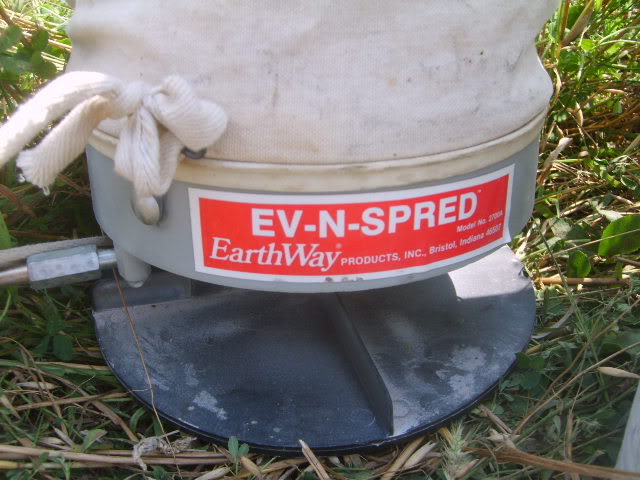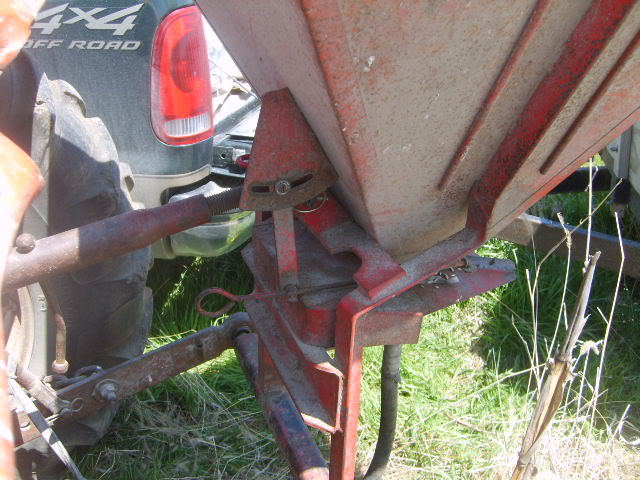dbltree
Super Moderator
Quick Guide to switchgrass establishment:
Kill cool season grasses the year before by mowing in early August and spraying with 41% glyphosate in late August thru October and add 2 ounces of Oust XP and one quart crop oil concentrate for added residual control. Re-spray any remaining re-growth in late September after remaining fescue seeds have time to germinate.
Keystone Pest is a source for generic Oust XP (SFM 75)
Planting RR soybeans the spring prior is the perfect way to prepare for switchgrass
Frost or dormant seed switchgrass late December thru March with late January to mid February being the most effective time period. Broadcast or drill on frozen soils at 5-10#'s per acre.
Cave In Rock is a preferred variety for whitetail cover (in midwest) because it is tall and thick cover that stands up better in winter.
Osenbaugh’s Prairie Seed Farms is a top quality source where you can also get personal service and answers to questions.
Spray glyphosate and atrazine by late April using 1 quart gly and 2 1/2 quarts atrazine on light soils, 4-5 quarts atrazine on heavy soils. If weed growth is not present then adding gly is unnecessary, using Oust the fall before usually negates the need for gly in the spring. Atrazine is a restricted use pesticide so will require hiring your ag co-op or area farmer to apply
Mowing may be required if any weed growth persists but keep mower raised 8-12" above the ground or it can damage or kill young switch seedlings.
Since switchgrass is a different "breed" so to speak then the rest of the NWSG, I thought I would make a separate post regarding it's establishment.

Switchgrass is in my opinion the very best cover for both deer and pheasants. The NWSG mixes have their place and if you can plant some of each, as I have, you can provide the best in nesting habitat and winter cover.

Switchgrass is the ultimate in winter cover because it will remain standing. A heavy wet winter snow will bend it over, but after a little sun it will spring back upright...the same cannot be said of other prairie grasses which can end up flat as a pancake by spring.
Switchgrass is best frost seeded because it needs to stratify by means of wet, freezing, thawing action common thru late Jan. to early March. It can be broadcast or drilled in killed sod or crop stubble at 5-6# per acre.


A bag seeder works well for larger acreages

3 pt seeders will also work well but adjust the opening to barely the width of the small seed or you'll end up with "dumped" in a small area.

Drills work well on frozen soils in late winter and see need only be dropped on the surface

Switchgrass is like corn, it loves nitrogen and is atrazine resistant. Atrazine is a RUP (restricted use pesticide) so you either need to have the elevator or a farmer with a RUP applicator license apply it. (or have a farmer friend buy it for you and put it on yourself
Atrazine can be put on at 2-4 qts per acre (more is better)...you can't kill it and if you control weeds and grass it will go like gang busters the first year.
Spray small areas by hand:

or larger areas with a field sprayer:

NOTE: Journey herbicide can kill or injure new seedlings so is not the best bet for straight switch. You can apply Journey to established switch when it is dormant (very early spring)
If you control weeds by mowing, it will take 3 very long years!! If you mow...do not mow more then 8-12" high as you can easily kill new seedlings.
Once established it is best to burn every 3-5 years, or mowing if burning is not an option.

Do not apply nitrogen on a new seeding as it will only encourage weed growth, after that it's optional. If you have good corn ground it will do fine with out any help. On poor ground you can thicken the stand with fertilizer.
I find that deer love my switchgrass year around! Beds abound in it and I have jumped countless bucks that left me agape as I watched them vanish in the tall grass.


The power plant at Ottumwa is currently using baled switchgrass along with coal to fire the plant. It's hoped that switchgrass will become a viable, renewable power source as well as income for producers with HEL.
If you are not signing up a new CRP contract (which will require the NWSG mix) you may prefer to give straight switchgrass a try...for deer cover, you won't be sorry!
Here's a great link to more info on establishing switchgrass.
Seeding Recommendations
Osenbaugh’s Prairie Seed Farms is a great Iowa seed source
While Cave In Rock is my favorite for holding mature whitetails, there are many varieties to choose from. There are two main types of switchgrass: upland types, which usually grow 5 to 6 feet tall and are adapted to well drained soils, and low land types, that grow up to 12 feet tall and which are typically found on heavy soils in bottom-land sites.
I have found that most other varieties other the CIR tend to die out over time and you can see pictures and examples further along in this thread.
Switchgrass varieties:
Planting 5-6#'s per acre in February or March to help stratify dormant seed, broadcast or drill into killed frozen sod. It is important to remember that switchgrass seed is often naturally dormant may not germinate with out being stratified first. Stratification occurs naturally in the wild by being exposed to the cold wet chill of late winter rains and freezing/thawing action. It also can occur by aging seed for 1- 3 years but then the number of viable seeds per pound can begin to drop as well.Upland varieties
Cave In Rock is one of the tallest, rankest, most winter hardy and longest lived
Shawnee and CIR are the two top varieties in Iowa tested for bio-fuels production
Trailblazer is a good tall variety
Nebraska 28
Blackwell a shorter variety better suited for upland bird habitat
Caddo
Pathfinder
Forsetburg Upper plains states
Dakotah
Lowland varieties
Alamo
Kanlow
<table id="table21" class="emphasis-pub-lightyellow" border="1" cellpadding="3" cellspacing="0" width="100%"><tbody><tr><td colspan="2" bgcolor="#ffff00">Upland Varieties</td></tr><tr><td width="14%">Trailblazer</td><td width="86%">Developed by USDA-ARS and Nebraska Agricultural Research Division, Dept. of Agronomy, Univ. of Nebraska. Released 1984. Collections from natural grasslands in Nebraska and Kansas. Adapted to Central Great Plains and adjacent Midwestern states. (Good choice for Midwestern / Southern state areas)</td></tr><tr><td>Blackwell</td><td>Developed by Plant Materials Center, NRCS, Manhattan, Kansas. Released 1944. Upland type switchgrass. Widely adapted to Kansas, Oklahoma, southern Nebraska, and northern Texas in areas with 20 inches or more of annual precipitation. (Good choice for Midwestern / Southern state areas)
Technical Info:
http://www.plant-materials.nrcs.usda.gov/news/features/great_am_plant/blackwell.html
</td></tr><tr><td>Cave-in-Rock</td><td>Plant Materials Center, NRCS in cooperation with the Missouri AES. Released 1973. Tolerant to flooding. Adapted to Midwest. (Good choice for Midwestern / Southern state areas)
Tech Info: http://www.plant-materials.nrcs.usda.gov/pubs/mopmcfscavinroc.pdf
</td></tr><tr><td>Dacotah</td><td>Northern state variety.
Tech Info: http://www.plant-materials.nrcs.usda.gov/pubs/ndpmcrbpavi2daco.pdf
</td></tr><tr><td>Pathfinder</td><td>Selected at Nebraska AES, Lincoln, ARS cooperating. Released 1967. Winter-hardy, late maturing. (Good choice for Midwestern / Northern state areas)</td></tr><tr><td>Sunburst</td><td>Northern state variety. (Good choice for Northern states) - Larger seeds are ideal for wildlife food purposes.</td></tr><tr><td>Caddo</td><td>Selected at Oklahoma AES, Stillwater, ARS cooperating. Released 1955. Forage yield under irrigation outstanding for native grass; recovers well after mowing.</td></tr><tr><td colspan="2" bgcolor="#ffff00">Lowland Varieties</td></tr><tr><td>Alamo</td><td>Developed by Texas Agricultural Experiment Station and NRCS, Knox City, Texas. Released 1978. A premier lowland variety, heavy yields especially in the south. (Good choice for Southern states)
Technical Info: http://tfss.tamu.edu/pasture_grasses.htm
</td></tr><tr><td>Kanlow</td><td>Developed at Kansas AES and ARS, Manhattan. Released 1963. Developed for soil conservation in poorly drained or frequently flooded sites. (Good choice for Midwestern / Southern states)
Technical Info: http://okcrop.com/kanlow_switchgrass.htm
Also: http://www.plant-materials.nrcs.usda.gov/pubs/kspmcnl7249.pdf
</td></tr><tr><td colspan="2">Basic variety info Source: Oregon State University, 2006. </td></tr></tbody></table>
Frost or dormant seeding is the natural way that switchgrass perpetuates itself in a wild prairie but common perception is that the soil must be tilled and the tiny seeds "planted" like conventional crops. This is the largest cause of failure or delayed germination as dormant seed lays there until exposed to cold wet chill the following year.
Cave In Rock is one of the most sought after switchgrass varieties because it is such a tall and dominate species but it is also one of the most dormant seeds. Dormancy however is not an issue when seed is broadcast or drilled onto frozen soils in February or March.
Blackwell is one of the least dormant along with NE28 and are better suited for spring drilling but they are more susceptible to rust and disease then Cave In Rock and therefor may not be as long lived.
Tilling the soil is not only unnecessary but only encourages weeds, erosion and increases the expense of establishing switchgrass and does NOTHING to better the odds of establishing a stand. Odds of failure have proven lowest among frost seed switchgrass stands.
Dormant seeding is the least expensive most successful method of sowing all NWSG and forbs and that makes it easy for almost anyone to plant them with little or no equipment.
Switchgrass will grow on most soils from sand to heavy clay but thrives on rich moist soils and can handle some brief flooding along waterways.
Herbicides Atrazine or simazine at no less then 2.5 quarts per acre before weeds emerge and they can be combined for more effective weed control.
Atrazine is a Restricted Use pesticide that requires a license to purchase so that requires having an ag co-op/farm elevator apply it of purchasing thru a farmer or friend who has a license. Although atrazine has received a great deal of attention because it has been applied at up to 34.7 million gallons on our nations corn fields, thus ending up in waterways and drinking water, it is NOT a problem for a one time application to establish switchgrass.
Atrazine 4L herbicide label
Simazine (brand name Princep 4l) is an unrestricted trizine herbicide that can be used alone or in conjunction with atrazine or Oust XP at roughly 2 quarts per acre. Both simazine and Oust XP are commonly used on tree plantings so are useful herbicides in anyone's habitat program.
Simazine 4L herbicide label
Oust XP has proven to also be a highly effective pre-emergent herbicide for weed control in switchgrass plantings. Use 1-2 ounces per acre (it can be fall or spring applied before switchgrass emerges) and runs roughly $5.50 an ounce from Townsend Chemical. The label recommends that one wait 3 months before planting switchgrass if 2 ounces of Oust is applied so applying in late fall or early spring is safest, although I have had no problems with late spring and switchgrass emergence.
Oust XP Label
Townsend Chemical will sell Oust XP by the ounce (minimum 2 ounces ) and it runs under $6 an ounce.
Townsend Chemical
Paramount (Quinclorac) is a post emergent herbicide approved for switchgrass, big and little bluestem and side oats gama and applied at 5.3-8 ounces per acre as is effective at controlling emerged foxtail.
Paramount Label
Drive 75 is another Quinclorac product identical to Paramount but available in smaller more affordable quantities
Drive 75 Herbicide - 1 LB (Quinclorac, Quinstar)
DRIVE 75 DF HERBICIDE WEED CONTROL CRABGRASS Quinclorac
Paramount and Drive 75 can be applied to growing switchgrass and will effectively kill growing foxatil and other annual weeds.
Dual Magnum II (S-metolachlor) works very well and is not a RUP but it can cause problems unless the seed is safened (protected) with a seed safener like Concep, an inexpensive product that is used to safen sorghum seed as well. Dual can be applied at up to 2.5 pints per acre and can be applied in combination with both atrazine and simazine including a combination of all three.
Concep Seed Safener source
Dual MagnumII Label
Cinch ATZ is a pre-mixed combination of atrazine and s-metolachlor.
Accent is approved for corn and switchgrass primarily for controlling annual grasses but it quite expensive.
Accent Label
Accen Source
After switchgrass has 3-4 leaves, use 2-4D at 1-3 quarts per acre to kill broadleaves.
Burning Maintain switchgrass plantings by burning every 3-5 years although more frequent burnings are helpful. It is very important to burn late in the spring, late April through mid May to set back and discourage cool season invasives and encourage the switchgrass (and other natives). The switch will grow quickly on the sun warmed blackened soil allowing it to over power and dominate other invasive species.NOTE: A combination of glyphosate, atrazine and/or simazine and crop oil can be applied up to May 10th to both kill late germinating cool season grasses and provide season long control.
Lime and fertilizer
Switchgrass will respond to proper soil nutrition even though it will grow on almost anything. Soil testing is recommended first and applications of lime and P&K the fall before is best. With excellent residual weed control, nitrogen can be applied the establishment year and like corn, switch will grow quickly with higher N levels. Without good weed control however nitrogen will only encourage a flush of weed growth and have the opposite affect on the seedling switchgrass.
Once established urea can be applied in mid to late June just before a minimum of a 1/2" of rain to encourage tall robust growth. Burning however is all that is really needed to turn straw and thatch into nitrates that the plant can use and is the inexpensive and natural way to rejuvenate and encourage switchgrass growth.
Switchgrass is the most popular and easily managed native grass in the Midwest. Seeding this warm season grass can vary from region to region and even site to site but there is one fail safe way to get results on your pure stand of Switchgrass, that’s a frost seeding. To ensure the maximum results from your frost seeding, you should broadcast the Switchgrass before February 28th. Even with snow on the ground you should broadcast right on top, the Switchgrass will work its way down to the soil. Ideally it’s best to broadcast right before a good snow and let that accumulation help the Switchgrass seeds settle into the ground.
Prairie Seed FarmsThen right around April 1st it’s recommended to apply 2-4 pounds/quarts to the acre of Atrazine to your initial seeding. This pre-emergence herbicide will keep most annual weeds from sprouting. Another option instead of using Atrazine is to clip the weed canopy when it blocks at least 50% of the sun energy from getting to the new seedling. This may take up to 6 times the first year to allow the Switchgrass to grow unabated. Both of these approaches help the new seedlings establish themselves in the soil so they can overtake the other grasses, such as brome, that already exist. May 5th – 10th you should spray the field with Round-up to kill the brome, and get rid of any competition for the Switchgrass. Frost seeding Switchgrass will give you a good solid stand with the least amount of maintenance, and provide many years of wildlife attracting habitat and provide excellent hunting grounds.
Osenbaugh's Prairie Seed Farms
Nathan Pace- Sales Consultant
800-582-2788 - Office
641-766-6795 - Fax
515-975-1400 - Cell
nate@prairieseedfarms.com
Switchgrass Seed Dormancy issues
Stratification in Switchgrass Seeds
Planting and Wet-chill to break dormancy
Breeding forReduced Post-Harvest Seed Dormancy in Switchgrass
Other suppliers:Because of its potential as a renewable biofuels crop, interest<sup> </sup>in the grass is increasing and the land area being planted to<sup> </sup>switchgrass is expanding. However, establishment of desirable<sup> </sup>stands can be a problem because post-harvest seed dormancy causes<sup> </sup>low germination and slow seedling development (Beckman et al., 1993;<sup> </sup>Zarnstorff et al., 1994). Post-harvest dormancy in recently<sup> </sup>harvested seed of some switchgrass cultivars can be as high<sup> </sup>as 95%, and the seed can require up to 2 yr of after-ripening<sup> </sup>to become germinable (Shen et al., 2001). This lengthy after-ripening<sup> </sup>period can be reduced by cold stratifying the seed (Zarnstorff et al., 1994;<sup> </sup>Shen et al., 2001) or treating the seed with different chemicals<sup> </sup>or growth regulators (Haynes et al., 1997; Tischler et al., 1994;<sup> </sup>Zarnstorff et al., 1994). Stratification is the most practical<sup> </sup>approach to break dormancy because it can be accomplished simply<sup> </sup>by planting the seed, provided the soil environmental conditions<sup> </sup>meet the stratification requirements. However, this also can<sup> </sup>be problematic. If switchgrass seed are planted into moist,<sup> </sup>cool soil in the spring, several weeks of stratification are<sup> </sup>required before germination is initiated, but uncontrollable<sup> </sup>environmental events can negatively impact stratification and<sup> </sup>subsequent germination. If seed are planted into a dry soil,<sup> </sup>for example, stratification is initiated only after a rainfall<sup> </sup>event, and the soil temperature must be low enough to chill<sup> </sup>the seed before germination. If it does not rain until late<sup> </sup>spring or early summer, the soil temperatures can be too high<sup> </sup>for stratification to occur, and germination is delayed until<sup> </sup>the temperature and moisture conditions are favorable, which<sup> </sup>may not occur until the following spring.<sup> </sup>
<sup></sup>
Even if the conditions for stratification are met and the seed<sup> </sup>germinate, seedlings emerging in late spring or early summer<sup> </sup>face the prospect of unreliable rainfall, which also can negatively<sup> </sup>impact stand establishment. An approach that can circumvent<sup> </sup>these uncontrollable environmental events is to artificially<sup> </sup>stratify the seed before planting, but this also can be problematic.<sup> </sup>If the seed are artificially stratified but the weather or soil<sup> </sup>conditions are not conducive to planting, the seed must either<sup> </sup>be placed in cold storage or quickly dried to prevent sprouting.<sup> </sup>Unfortunately, drying stratified seed can cause some of them<sup> </sup>to revert back to a dormant state
Sharp Brothers Seed
Ernst Seed
Welter seed
Bamert Seed Company
Stock Seed Farms, Inc.
Browning Seed
Turner Seed
Seedland
nannyslayer here on this site carries Cave In Rock switchgrass seed, just send him a PM
Last edited:














